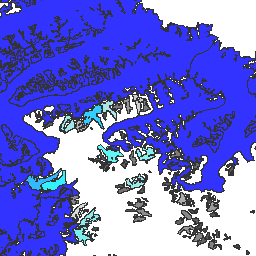
- Dataset-Verfügbarkeit
- 1750-01-01T00:00:00Z–2023-06-07T00:00:00Z
- Dataset-Anbieter
- National Snow and Ice Data Center (NSDIC)
- Tags
Beschreibung
Global Land Ice Measurements from Space (GLIMS) ist eine internationale Initiative, die darauf abzielt, die geschätzten 200.000 Gletscher der Welt wiederholt zu erfassen.
Ziel des Projekts ist es, ein weltweit umfassendes Inventar von Landeis zu erstellen, einschließlich Messungen der Gletscherfläche, Geometrie, Oberflächengeschwindigkeit und Schneegrenze. Für diese Analysen verwendet das GLIMS-Projekt Satellitendaten, hauptsächlich vom Advanced Spaceborne Thermal Emission and Reflection Radiometer (ASTER) und vom Landsat Enhanced Thematic Mapper Plus (ETM+), sowie historische Informationen aus Karten und Luftbildern.
Jedes Feature in diesem Dataset ist eine polygonale Grenze eines Gletschers zum Zeitpunkt der Analyse. Einige Gletscher-IDs haben im Laufe der Zeit Hunderte von unterschiedlichen Zeilen.
Dieses Dataset ist eine Momentaufnahme des Inventars der Gletschergrenzen vom 7. Juni 2023 und enthält über 1.100.000 Zeilen.
Tabellenschema
Tabellenschema
| Name | Typ | Beschreibung |
|---|---|---|
| Analysten | STRING | Name(n) des/der Datenbeitragenden |
| anlys_id | DOUBLE | ID eines Gletschers zu einem bestimmten Zeitpunkt |
| anlys_time | STRING | Wann die Analyse durchgeführt wurde |
| Fläche | DOUBLE | Fläche des Gletschers in der Ebene der Kartenprojektion in Quadratkilometern |
| chief_affl | STRING | Zugehörigkeit des Leiters des regionalen Zentrums |
| db_area | DOUBLE | Wie „area“, aber vom GLIMS-Projekt neu berechnet |
| geog_area | STRING | Name der geografischen Region, die vom regionalen Zentrum abgedeckt wird |
| glac_id | STRING | Die GLIMS-Gletscher-ID |
| glac_name | STRING | Der Name des Gletschers. Bei etwa 80% der Zeilen ist „None“ angegeben. |
| glac_stat | STRING | Glacier-Status, entweder „exists“ (vorhanden) oder „None“ (kein) |
| Länge | DOUBLE | Länge des Gletscherumrisses in Metern |
| line_type | STRING | Gletschertyp, z.B. „glac_bound“ für Gletscher oder andere Werte für interne Felsen, Schneegrenzen, Wasser usw. |
| local_id | STRING | ID, die von der beitragenden Institution oder dem regionalen Zentrum zugewiesen wurde |
| max_elev | DOUBLE | Höchster Teil des Gletschers in Metern über dem Meeresspiegel |
| mean_elev | DOUBLE | Mittlere Höhe des Gletschers über dem Meeresspiegel in Metern |
| min_elev | DOUBLE | Tiefster Teil des Gletschers in Metern über dem Meeresspiegel |
| parent_id | STRING | ID des Gletschers, der das übergeordnete Element dieses Gletschers ist |
| primeclass | DOUBLE | WGMS-Gletscherklassifizierungsnummer |
| proc_desc | STRING | Beschreibung der Verarbeitung dieses Datensatzes |
| rc_id | DOUBLE | Vom regionalen Center verwendete ID |
| rec_status | STRING | Status des Eintrags |
| release_dt | STRING | Datum, an dem die Daten veröffentlicht wurden, im Format JJJJ-MM-TTTHH:mm:ss |
| src_date | STRING | Datum der Quellbilder, die zum Erstellen des Umrisses verwendet wurden |
| subm_id | DOUBLE | Die von GLIMS zugewiesene ID der Einreichung |
| Einreicher | STRING | Name(n) des/der Dateneinreicher(s) |
| wgms_id | STRING | World Glacier Monitoring Service-ID |
| Breite | DOUBLE | Breite des Gletschers in Metern |
Nutzungsbedingungen
Nutzungsbedingungen
Bei der Erstellung von Berichten, Publikationen, neuen Datensätzen, abgeleiteten Produkten oder Diensten, die aus dem Datensatz resultieren, sollten Nutzer Folgendes angeben: GLIMS und NSIDC (2005, aktualisiert 2013): Global Land Ice Measurements from Space glacier database. Zusammengestellt und zur Verfügung gestellt von der internationalen GLIMS-Community und dem National Snow and Ice Data Center, Boulder CO, USA, doi:10.7265/N5V98602
DOIs
Earth Engine nutzen
Code-Editor (JavaScript)
var dataset = ee.FeatureCollection('GLIMS/current'); var visParams = { palette: ['gray', 'cyan', 'blue'], min: 0.0, max: 10.0, opacity: 0.8, }; var image = ee.Image().float().paint(dataset, 'area'); Map.setCenter(-35.618, 66.743, 7); Map.addLayer(image, visParams, 'GLIMS/current'); Map.addLayer(dataset, null, 'for Inspector', false);
Als FeatureView visualisieren
Ein FeatureView ist eine beschleunigte Darstellung eines FeatureCollection, die nur angezeigt werden kann. Weitere Informationen finden Sie in der Dokumentation zu
FeatureView.
Code-Editor (JavaScript)
var fvLayer = ui.Map.FeatureViewLayer('GLIMS/current_FeatureView'); var visParams = { color: { property: 'area', mode: 'linear', palette: ['gray', 'cyan', 'blue'], min: 0.0, max: 10.0 }, opacity: 0.8, polygonStrokeOpacity: 0 }; fvLayer.setVisParams(visParams); fvLayer.setName('GLIMS/current'); Map.setCenter(-35.618, 66.743, 7); Map.add(fvLayer);
